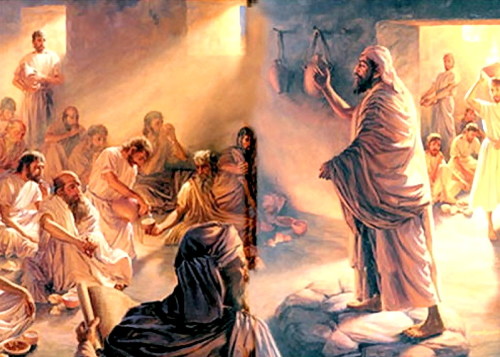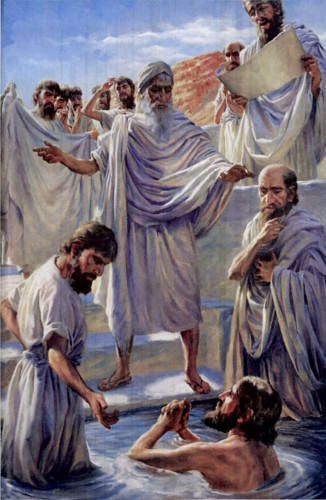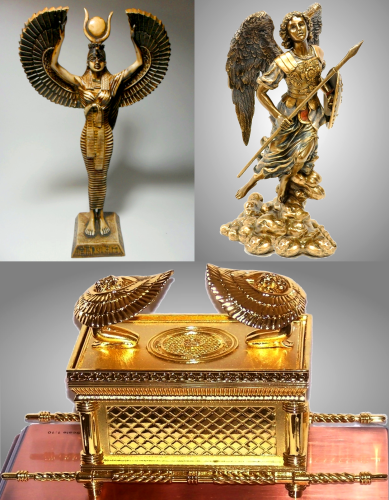- Home
- Legitimacy
- Ancient Denomination
Denomination of Ancient Christianity
The Original 1st century Denomination of Ancient Christianity
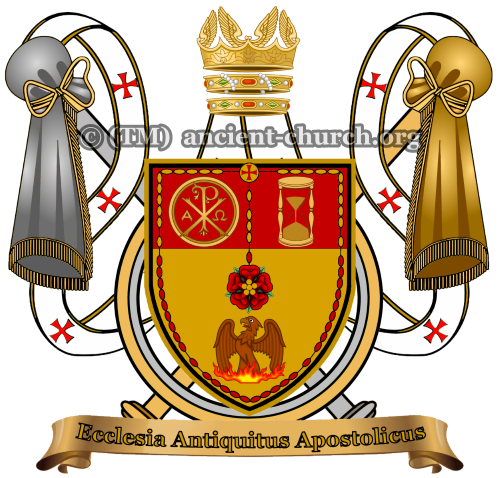
Official Heraldic Seal of the Ancient Apostolic Church, continuation of the Ancient Priesthood of Solomon of the Knights Templar of 1118 AD
Ancient Catholicism is the primary and original denomination, which is the earliest pre-Christian source of all classical Christianity. As a canonical denomination with inherent Pontifical authority, it is the exclusive heritage of the Ancient Apostolic Church, a sovereign ecclesiastical institution which was preserved and restored by the Order of the Temple of Solomon (the original institution of the “Knights Templar”).
The Ancient Catholic traditions are the result of direct initiatory and doctrinal succession from the Ancient Priesthood of the Biblical King Solomon. Ancient Catholicism is completely free from “dogmas”, as it predates all later derivative doctrines which developed after the 1st century. It is a “non-denominational” denomination (ironically), because it embodies the underlying foundations of all Christian denominations, which continued through the Essenes to be practiced and taught by Jesus to the Apostles. It has a strong basis for interfaith ecumenical cooperation, because it preserves the most universal doctrines underpinning all denominations of all genuine spiritual religions.
The Ancient Priesthood of Solomon, which continues through the inclusive denomination of Ancient Catholicism, essentially “invented” the most fundamental doctrines and sacred practices of classical Christianity, including: Original Monotheism, the Ten Commandments, the Holy Spirit, Baptism, Holy Water, Holy sacraments, Communion of the Eucharist, and the Veneration of Angels and Saints with icons and statues. It is also the source of consecrating Clergy, consecrating ceremonial vestments and implements, and the structure of ranks of Clergy. Even the iconic Saint Peter’s Keys directly came from the Ancient Priesthood.
(To be able to View the ancient Egyptian inline notations on parts of this page, “RIGHT-Click”and “Save” this Hieroglyphics Font, OR Download the NewGardiner Font HERE, and simply double-click on the TrueType Font file.)
Proprietary Research – This site presents new and original research, from primary sources in the historical record. The numbered source references are the verifiable evidence of all relevant facts. The Ancient Apostolic Church now shares this with the general public for the first time, as part of its core mission of restoring venerable traditions as the pillars of civilization.
Church & Order are Separate – The Ancient Apostolic Church is historically preserved and supported by the Order of the Temple of Solomon, which is separate and independent. The Church has its own Ecclesiastical Charter and Pontificate, and its Faithful and Clergy are not obligated to join the Templar Order. The Templar Order has its own Chivalric Constitution and Grand Mastery, and is interfaith and non-denominational, while separately supporting Ancient Catholicism. Templars are not required to participate in the Church.
© COPYRIGHT NOTICE – Copying whole sections or pages is prohibited, and subject to civil and criminal liabilities by law. Smaller parts can be used only with Attribution Credit and a Link to this website. Please see Legal and Attribution information in the Footer (bottom of this page).
Origins from the Ancient Priesthood of Solomon
The Order of the Temple of Solomon was first established in 1118 AD, specifically as a mission for the Cistercian Order of Saint Bernard de Clairvaux [1] to recover the Ancient Priesthood of Solomon, which the first Templar Knights restored by excavating the historical Temple of Solomon [2] [3] for a nine year period [4].
Authoritative historians (1st c. Flavius Josephus, 5th c. Procopius of Caesarea, 13th c. Patriarch of Jerusalem Urban IV, 19th c. Charles Addison) have confirmed that the famous site on Temple Mount was in fact that of the Biblical Temple of Solomon [5] [6] [7] [8]. The Biblical witness account of Ezekiel (Ezekiel 8:10-11), and site research by the 1st century historian Josephus, confirm that this Temple of Solomon, in fact, was actually a Temple of the Ancient Priesthood of Pharaonic Egypt [9] [10] [11]. University Bible scholarship of 20th century historians confirmed that when Ezekiel looked into the Holy of Holies, he saw “paintings… and other mythological scenes, motifs which seemed to point to syncretistic practices of Egyptian provenance.” [12]
Archaeology has proven that the Temple of Solomon contained a library of sacred scrolls [13], at the time when it was excavated by the Knights Templar, placed there by the 1st century Essenes [14], by a particular group of Essenes from Egypt [15], who had direct access to that site [16]. The legendary “Treasure of the Templars” was thus the Library of the Temple of Solomon, which gave the first Knights Templar full access to copies (as duplicate manuscripts were common) of all ancient scriptures, and other artifacts, as well as the hieroglyphic and Coptic inscriptions on the walls of this Pharaonic Egyptian Temple.
Scripture indicates that Jesus had been exposed to basic beliefs of the Ancient Priesthood in Egypt, for as many as 12 years during his early childhood (Matthew 2:13-15) [17]. Other evidence demonstrates that Jesus later studied with the Essenes in Alexandria Egypt for at least several years of an 18 year period (until beginning his active Priesthood at age 30), especially his teachings mirroring the words and doctrines of Egyptian papyrus scrolls and the Dead Sea Scrolls of the Essenes [18] [19].
This theory of traditional Templar “oral history” is confirmed by other evidence that Jesus was a High Priest of the original Egyptian Essenes called the “Nazarenes” [20]. The New Testament specifically confirms that the 1st century Priesthood of Jesus himself was called the “sect of the Nazarenes” (Acts 24:5) [21]. Authoritative Bible scholars established that the Greek adjective ‘apo Nazaret’ (“from Nazareth”) was a 4th century mistranscription of the original correct Greek adjective ‘Nazarenos’ (“the Nazarene”) as a title meaning “the Nazarene Essene”, which was used in other parts of the New Testament [22].
University professors explain that Jesus was not “of Nazareth”, but was actually called “the Nazarene”, revealing that he was a High Priest of the Nazarene Essenes, the original Egyptian Essenes. (The town “Nazereth” did not have that name at the time of Jesus, such that he was not named after the place, but rather the town was later named after Jesus the Nazarene Essene.) [23]
The word “Nazarene” comes from the Aramaic word ‘Nasuraiia’, meaning the High Priests (“Nasoraens” or “Nazarenes”) of the pre-Christian Gnostic Mandaens of ancient Mesopotamia. The word ‘Nasuraiia’ comes from the Egyptian hieroglyphic root word ‘N-S-R’ 𓈖 𓋴 𓂋 (water-cloth-mouth) meaning “to keep” as in “Keepers of the Law of God” [24]. Bible scholars confirm that some of the New Testament references to Jesus are most correctly translated as “the Nazorean” (e.g. Luke 18:37), because the additional vowel in Greek prevents it from mistranslation as “of Nazareth” [25]. One passage in the Gospel of Matthew explicitly uses and correctly translates the original Aramaic word “Nazorean”, citing a prophecy that “He [Jesus] will be called a Nazorean.” (Matthew 2:23) [26]
These verified facts of the historical record conclusively prove that the Biblical Jesus was in fact a High Priest of the ancient Mesopotamian Gnostic Priesthood, as continued through the Egyptian Priesthood of Nazarene Essenes. These same Egyptian and Essene doctrines of the Temple of Solomon consisted of the ancient origins and underlying foundations of Christianity [27].
What became commonly known as the “Templar Priesthood”, which the founding Templars recovered and restored from the historical Temple of Solomon, was thus the Ancient Priesthood of Solomon. That sacred Biblical Priesthood is canonically a part of Catholicism, consisting of the ancient Mesopotamian, Egyptian and Essene origins of classical Christianity, precisely as authentically taught by Jesus himself. It is that Solomonic Priesthood, as continued by Jesus, which constitutes the original ecclesiastical denomination of Ancient Catholicism.
Pontifical Denomination of Ancient Catholicism
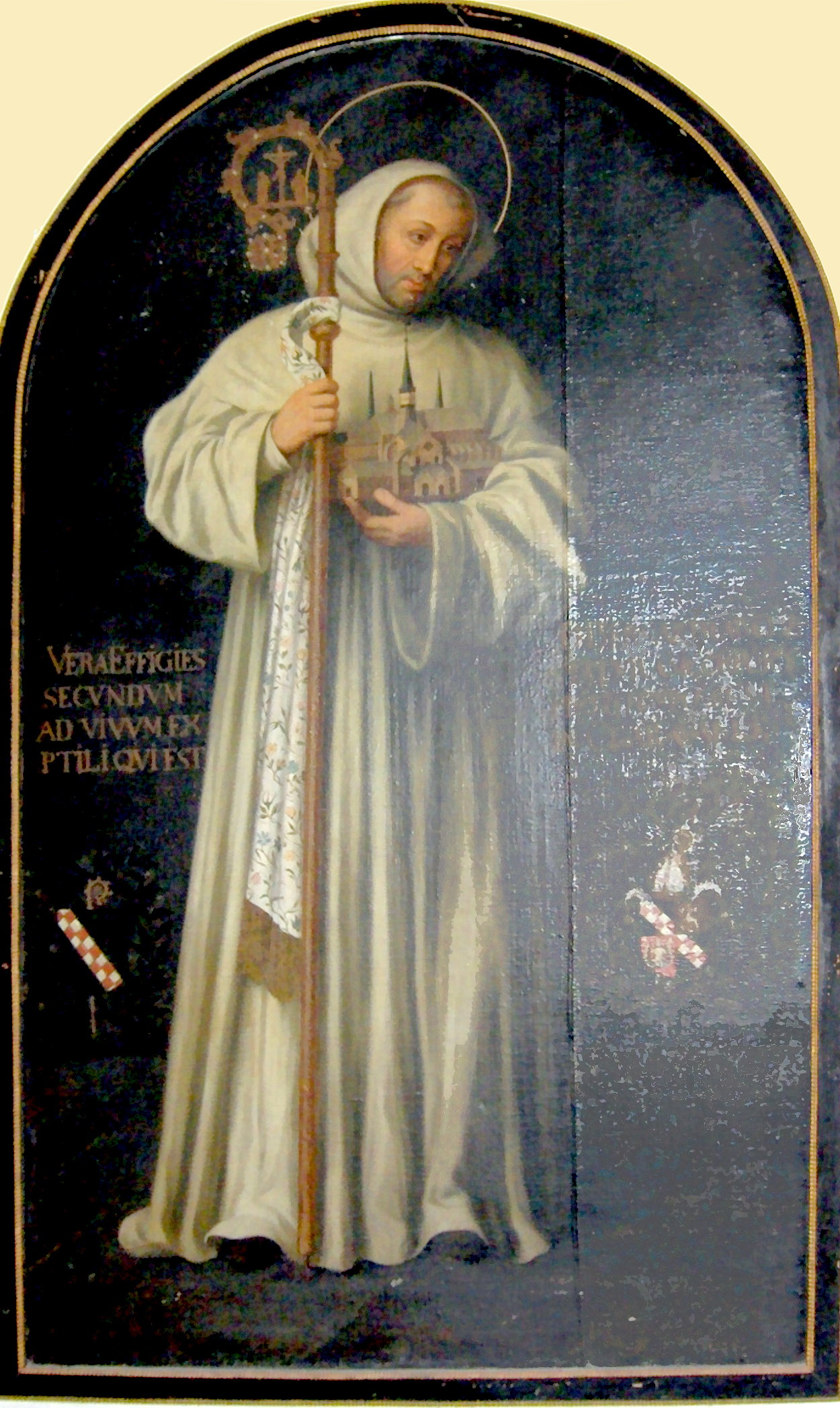
‘Bernard of Clairvaux’, True Effigy by Georg Andreas Wasshuber (1700 AD) in Heiligenkreuz Abbey Church near Baden bei Wien, Austria
The Temple Rule of 1129 AD from the Cistercian Saint Bernard de Clairvaux, as a Papal Decree ratified by the Vatican Council of Troyes, recognized the Templar Order as being founded within its own religion: The Order is called a “Holy Communion” in its own right, describing it as “this Religion” as distinct from other religions (Rule 2) and “the Religion of knighthood” (Rule 14), calling it a “type of new Religion” as different and unique, a “Religion of Knights” and also “Religion by armed knighthood” (Rule 57), and using the phrase “in every Religion” as including the Templar Order as one among other separate religions (Rule 71) [28].
The Temple Rule also recognized the Templar Priesthood as being its own original denomination of Ancient Catholicism: It describes the Templars as “Disciples” of the Grand Master, confirming its own unique religious tradition (Rule 7), uses an obscure Old Latin phrase to inconspicuously mention the “Patriarchate of the Temple of Solomon”, subtly indicating its own Pontifical authority (Rule 8), describes Templar ecclesiastical sovereignty as “divine service… dressed with the crown” (Rule 9), declares the Grand Mastery to be exercising its own ecclesiastical authority (Rule 62), and describes “servants of the Church” as under command of the Grand Master, confirming independent Pontifical authority (Rule 64). [29]
Certain key statements in the Temple Rule prove that the Vatican’s official recognition of the unique and independent ecclesiastical authority of the Ancient Priesthood of Solomon, as the denomination of Ancient Catholicism, was not accidental, nor unnoticed. Rather, it was deliberate and intentional recognition, based upon a full and transparent presentation of the Templar Priesthood: The scribe witnesses that “the manner and establishment of the Order of knighthood we heard” (Rule 3), the Templars “presented… the customs and observances of their humble beginnings… to make all known” (Rule 7), and the ancient priestly origins were fully “considered and examined through diligence and study of the Holy Scriptures” (Rule 8). [30]
The Vatican Papal Bull Omne Datum Optimum of 1139 AD, which granted permanent independent sovereignty of statehood to the Templar Order, was issued by Pope Innocent II, who rose to the Papacy, overcoming adversity, supported by Saint Bernard [31]. It was that same Saint Bernard who had supported the original founding Templar mission to recover the Ancient Priesthood from the Temple of Solomon [32]. This fact evidences that the irrevocable Vatican grant was specifically based upon the Order’s own inherent ecclesiastical authority from the Ancient Priesthood of Solomon, thereby becoming the unique denomination of Ancient Catholicism.
Key references in this Papal Bull confirm that such recognition of the denomination of Ancient Catholicism was intentional: It highlights “the religious life… established in your house [Temple]… [by] divine grace… inviolably”, meaning that the Ancient Priesthood was “established” from the Temple of Solomon (and thus not from the Vatican), thereby necessarily holding inherent ecclesiastical sovereignty, as an original denomination of early Christianity. It emphasizes that “the house [Temple]… [is] the source and origin of your Holy institution and religious Order, so it shall be… forever the head and ruler” of its domain, meaning that because the Temple of Solomon is the source of the Ancient Priesthood of the Order, precisely for that reason, it holds ecclesiastical sovereignty. It mandates that “the customs [laws] instituted… by the [Grand] Master… of your religion… may not be infringed nor diminished by any ecclesiastical or secular person”, thus specifically meaning ecclesiastical sovereignty as a Pontifical denomination in its own right. [33]
Biblical King Solomon of Ancient Catholicism
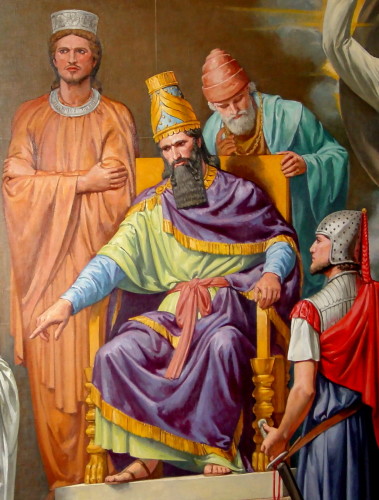
‘King Solomon’ mural in the Cryptic Room of the George Washington Masonic National Memorial, depicting Solomon as Pharaonic-Mesopotamian (Detail)
Archaeology of the 19th century generally held that the Biblical King Solomon personified “a kingdom that stretched from Egypt to Iraq”, which includes all of Sumerian Assyrian Mesopotamia [34]. The Old Testament records that “Solomon reigned over all kingdoms from the river [Euphrates]… and unto the border of Egypt” (I Kings 4:21) [35] The earlier Greek word for “unto” in this passage is ‘heos’, also meaning “down” as in “continuing through”, and the Greek for “border” used here is ‘horion’ meaning a wider and inclusive “region” [36] [37]. Therefore Solomon’s territory was from the Euphrates which runs across the middle of both modern Syria and Iraq, down through and including the territory of Egypt.
The Biblical account that “Solomon reigned over all the kingdoms” (I Kings 4:21) would be impossible for a secular King of any territory or nationality, but would require a full empire, which would be extensively documented in the historical record, whereas the person and “kingdom” of the Bibilical Solomon left hardly any traces [38]. Such influence “over all” secular Kings of the participating countries (without being an empire) is only possible by one historical model of customary international law: This could only be a Pontifical Ecclesiastical Catholicate, such as the Holy See of the Roman Catholic Church, which thereby influenced many Kings of the Holy Roman Empire and throughout Europe thereafter.
This was the situation in ancient Egypt and Mesopotamia – that the Ancient Priesthood of Solomon constituted an original religious denomination, possessing inherent ecclesiastical sovereignty. The Old Testament recounts that “Solomon’s wisdom excelled… all the wisdom of Egypt” (I Kings 4:30) [39] The Greek word for “excelled” used here is ‘plethuno’ [40], actually meaning “increased” or “made full” [41]. Therefore, this describes that the Biblical Solomon mastered, fulfilled, and even perfected the doctrines of the Ancient Priesthood of Egypt. Accordingly, Solomon was essentially a High Priest in the role of an ancient pre-Christian “Pontiff”, serving God as a Patriarch of the most refined and advanced denomination of the Ancient Priesthood.
The name “Solomon” is a direct form of the ancient Sumerian word ‘Salimatu’ [42] (ca. 2,800 BC) from early Akkadian language of Mesopotamia, meaning “Peace” [43]. This became the ancient Egyptian greeting ‘Salam’, pronounced from the triple consonant hieroglyphs ‘S-L-M’ 𓋴 𓄁 𓅓 (cloth-lion-owl), meaning “Peace”. This was used in the Egyptian Pharaonic “Amarna Letters” records of diplomatic correspondence (ca. 1,330 BC), to indicate health and well being, and more often referring to “peace gifts” [44].
The hieroglyphs for “Solomon”, as ‘S-L-M-N‘ 𓋴 𓄁 𓅓 𓈖 (cloth-lion-owl-water), add water waves to the end, the symbol for spiritual purification as priestly ordination (e.g. by Holy Water or Baptism), indicating that it would be a title for a Priest or Royal who is purified to embody “Peace”, and not really the name of a person. Therefore, the name “Solomon” by itself actually means “Priest of Peace” or “King of Peace”. Indeed, the name “King Solomon” is a proper grammatical form for “King of Salam”, literally meaning one who is anointed as “King of Peace”. This is confirmed in the Old Testament account that “Zadok the Priest… anointed Solomon. And… all the people said, God save King Solomon.” (I Kings 1:39) [45]
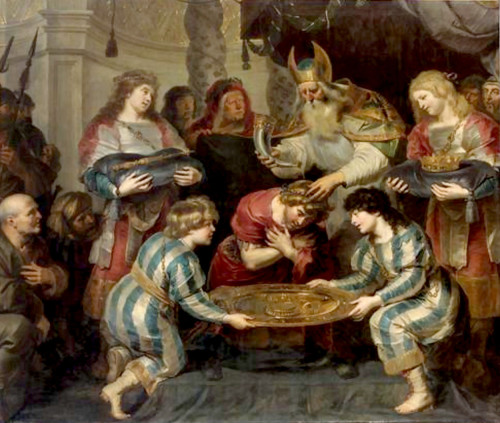
‘The Anointing of Solomon’ (ca. 1630 AD) by Cornelis de Vos, depicting the High Priest Zadok anointing Solomon (in I Kings 1:39)
In the Old Testament, the High Priest who anointed Solomon was called “Zadok”, a direct form of the ancient Ethiopian Amharic word ‘Sedeq’, meaning “Righteousness” [46], such that “Zadok the Priest” is actually a title meaning “High Priest of Righteousness” or “King of Righteousness”. The word ‘Sedeq’ (“Zedek” or “Zadok”) is the name of the ancient Sumerian “astral deity” considered “God Most High”, which was also called ‘Salim’, a name of the ethereal “City of God”, which became the word ‘Salem’ meaning “Peace”, as in the concept of heaven. [47] Accordingly, Zadok (or “Zedek”) also means “King of Peace”, as a High Priest title of an eternal Priesthood of the most ancient and most high God of the universe [48].
The fact that Solomon and Zadok both held exactly the same priestly title, reveals that Solomon was “anointed” not as a secular “King”, but specifically as a High Priest, continuing the Ancient Priesthood by succession from Zadok. In Old Testament descriptions of the Biblical Magi High Priests, “blessing” is used for ordination of a Priest or Episcopal consecration of the ancient equivalent of a Bishop, such that being “anointed” indicates enthronement of a King or a Pontiff, either as a co-regent or successor.
The Old Testament recorded that the High Priest Zadok was entrusted with the Ark of the Covenant (II Samuel 15:25), was “a seer” of the Ancient Priesthood (II Samuel 15:27), and preserved the true Ancient Priesthood when others went astray (Ezikiel 44:15, 48:11) [49]. This evidences that the Ancient Priesthood possessed original primacy of superior ecclesiastical authority over all other priesthoods.
In accordance with the above facts of the historical record, Solomon was anointed by a Sumerian High Priest, assuming a Pontifical role, in the most ancient Sumerian Priesthood, and given a Sumerian-Egyptian title. Solomon then perfected the Egyptian Priesthood, by reinforcing it with an infusion of its more ancient Sumerian roots, and spread that original Pontifical denomination throughout Egypt and Mesopotamia.
It was this Ancient Priesthood of Solomon which survived, to be fully restored by the modern Order of the Temple of Solomon, as the denomination of Ancient Catholicism, which is continued in the modern era through the Ancient Apostolic Church.
Most Ancient Origins of the Priesthood of Jesus
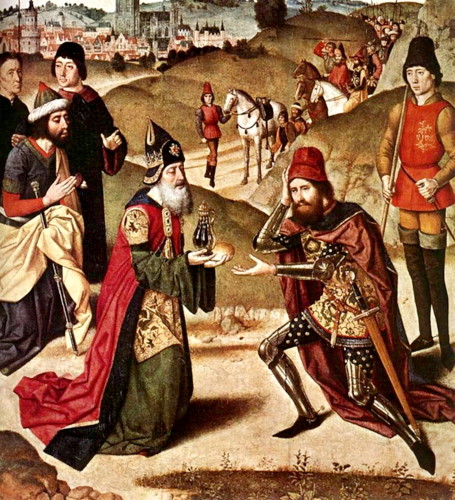
‘Meeting of Melchizadek and Abraham’ (c 1466 AD) by Dieric Bouts, in Church of St Peter, Leuven Belgium (Detail)
The name “Zadok”, of the High Priest who anointed Solomon (I Kings 1:39), is connected to another major priestly Biblical figure, that of Melchizedek, whose name is formed from the ancient Amharic Ethiopian words ‘Malki’ meaning “King”, and ‘Sedeq’ (“Zedek” or “Zadok”) meaning “Righteousness” [50]. Thus, the earlier “Melchizedek” is actually the same High Priest title “King of Righteousness” as held by Zadok who anointed Solomon. This connection is explicitly confirmed by the Old Testament reference to “Melchizedek King of Salem” (Genesis 14:18), the same alternate title “King of Peace” as the Sumerian title of Zadok [51]. This is further confirmed in the New Testament, which explains the title as “Melchisedec… King of Righteousness… also King of Salem… King of Peace” (Hebrews 7:1-2) [52]. “Melchizedek” is considered a theophoric name, indicating that it is a title held by successive masters of a multi-generational non-hereditary priestly lineage [53].
The New Testament describes the title of “Melchisedec” (alternate spelling) as being without genealogy, “having neither beginning of days nor end of life; but… abideth a Priest continually.” (Hebrews 7:1-3). This evidences that it is a non-hereditary title, of a Chief High Priest (analogous to a Pontiff), continued by initiatory and doctrinal succession, from the original and most ancient Priesthood of God in all of recorded history [54].
Ethiopia, the source of the ancient words forming the title “Melchizedek” (Malki-Sedeq), was closely connected with Egypt through Nubia of the Nile Valley, a major cultural corridor which the Pharaonic Priesthood treated as part of Egypt [55], and the Ethiopian population itself had migrated from the Nile Valley of Egypt during the Neolithic era [56]. This establishes that the High Priest title “Melchizedek” was formed by the Egyptian Priesthood, which used Nubian words from its South, then brought it into Mesopotamia to the North, through Egyptian controlled regions of Assyria [57].
An Old Testament account in the Book of Genesis identifies the Biblical figure of Melchizedek as a High Priest “of the most high God”, who “brought forth bread and wine, and… blessed [Abraham]”, an act which is widely considered the first Biblical sacrament, and the predecessor to the Eucharist of Christian Communion. This blessing took place immediately after Abraham’s victorious battle near Damascus in Assyria, from which he gave Melchizedek “tithes of all” the spoils (Genesis 14:18-20; Hebrews 7:1). [58]
The Biblical account in Genesis indicates that Melchizedek was present in Assyria. As “tithes” were customarily paid only to a recognized superior official authority, this demonstrates that Melchizedek held Pontifical authority representing the most ancient Sumerian Priesthood, which thereby had supremacy over all Kings and all other Patriarchs.
As described in the New Testament, this blessing by Melchizedek over Abraham, in turn, gave Abraham greater authority over other Priests, including the Levites (Hebrews 7:9), confirming the primary supremacy of the Magi Priesthood of Melchizedek [59].
These facts of the historical record reveal that the Biblical King Solomon was anointed by a High Priest of the Magi Priesthood of Melchizedek (I Kings 1:39) [60], to himself become Chief High Priest of that denomination, in the role of an ancient pre-Christian “Pontiff”. The Ancient Priesthood of Solomon (as recovered by the Knights Templar) thus carried the priestly lineage of non-hereditary initiatory and doctrinal succession, through Egypt, of the earliest Magi Priesthood of Melchizedek.
In the New Testament, Jesus is identified three times as a “High Priest” of the Melchizedek Priesthood (Hebrews 5:5, 5:6, 5:10) [61], by the original Greek word ‘Archiereus’ [62], which also means “Chief Priest” in the role of a Pontiff [63]. This Pontifical status of Jesus is described five times as “after the order of Melchizedek” (Hebrews 5:6, 5:10, 6:20, 7:17, 7:20) [64]. The word “after” is the Greek ‘Kata’ meaning “down from” and “by way of”, as lineal succession, and the word “order” is the Greek ‘Taxis’ meaning “appointed succession, position, rank” [65] [66].
Accordingly, the “order of Melchizedek” does not refer to any such monastic or chivalric “Order” (which did not exist), but rather means the Episcopal rank of Clergy in the Magi Priesthood of Melchizedek. Therefore, the repeated key phrase, that Jesus was “High Priest after the order of Melchizedek”, most correctly and literally translates from the original Greek as: “Pontiff by succession from the Episcopal rank of Melchizedek”.
Confirming that Jesus specifically taught and practiced the Ancient Priesthood, continuing it by initiatory and doctrinal succession, the New Testament in two places also refers to the Apostles and Disciples of Jesus as “High Priest” (Hebrews 5:1, 10:21) [67].
This proves that Jesus was recognized as the successor to Melchizedek’s position as Pontiff of the Ancient Priesthood, by lineal initiatory and doctrinal succession. It also proves that this most ancient Sumerian, Egyptian and Solomonic Priesthood, continued by the Egyptian Nazarene Essenes and later by the Knights Templar from the historical Temple of Solomon, carries inherent Pontifical authority, since time immemorial, as the original and unique canonical denomination of Ancient Catholicism. Moreover, this establishes that the Ancient Apostolic Church embodies the primary originating source and substance of the very same Ancient Priesthood of which Jesus himself became Chief High Priest.
Therefore, the Magi Priesthood of Melchizedek, which continued as the Ancient Priesthood of Solomon, is the most ancient source of the Pontifical denomination of the earliest form of Christianity. It was this original form of Christianity which was studied, mastered and taught by Jesus himself in the 1st century. The resulting denomination of Ancient Catholicism, thus carrying the underlying source and foundations of all Christianity, is continued through the Ancient Apostolic Church.
Ancient Origins of Fundamental Christian Practices
The canonical Pontifical denomination of Ancient Catholicism, as the living tradition of the Ancient Priesthood of Solomon, continuing the Magi Priesthood of Melchizedek, contains the full depth and substance of the original doctrines and practices, as later mastered and taught by Jesus to the Apostles, which became the Gospels of the Christian Faith:
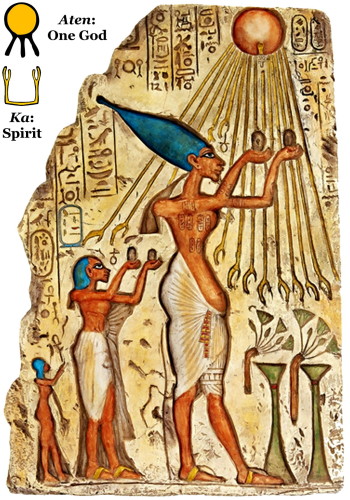
Akhenaten receiving the ‘Aten’ Holy Spirit through a sacramental offering (replica by Design Toscano)
Monotheism and the Holy Spirit – Monotheism was not brought to Christianity from supposed corrections of alleged “polytheism”, neither by the Prophet Moses nor the Pharaoh Akhenaten ca. 1,350 BC, but rather was an original and fundamental concept inherent in the Ancient Priesthood. The Egyptian Priesthood worshipped one singular supreme and universal God of all creation and nature, which was called the ‘Aten’. The pictorial hieroglyph for the Aten 𓇶 is a disk emanating rays of sunlight, with hands at the ends from the hieroglyph ‘Ka’ 𓂓 meaning “Spirit”, indicating that the rays are carrying spiritual energy from God, thereby establishing the concept of the “Holy Spirit” as in Christianity [68].
Proving that the Aten is the monotheistic One God, and not a “sun god”, papyrus scrolls describe it “as an orb emitting rays… giving ‘life’… interpreted as a sole ruler” [69]. Archaeology found the first recorded use of the Aten symbol in 2,687 BC [70], later as an alphabetically spelled word ca. 2,061 BC, which became closely associated with a “throne” of one supreme God ca. 1,569 BC, and was favored by Amenhotep III (who is associated with the Biblical Solomon as a title) ca. 1,400 BC [71].
The Old Testament confirms that the ancient Egyptian Aten is in fact the monotheistic God of the Bible, as the Book of Psalms contains the 13-line “Sun Hymn of Akhenaten” from the Tomb of Ay dated 1,343 BC, which praises the Aten as “creator and preserver of the world” with descriptions of God as nature (Psalm 104), replacing the name Aten with the Christian reference to “God” [72].
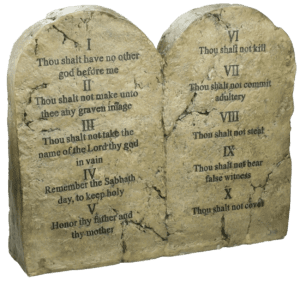 The Ten Commandments – Archaeology provides compelling and direct evidence that the Biblical “Ten Commandments” actually originated from the ancient Egyptian Priesthood. The Egyptian Book of Going Forth by Day (popularly called the “Book of the Dead”), Chapter 125 (sometimes called “Spell 125”, meaning a “Prayer”), is a Liturgy for the “weighing of the heart” at judgment when entering the afterlife. It developed from the Pyramid Texts as early as 2,345 BC, and was widely used as Papyrus scrolls from ca. 1,550 BC. This sacred text features the 42 “Negative Confessions” of the Goddess Maat (actually the “Angel” of Truth and Justice), declaring to the Angels that one has not committed any of a list of sins. [73] [74]
The Ten Commandments – Archaeology provides compelling and direct evidence that the Biblical “Ten Commandments” actually originated from the ancient Egyptian Priesthood. The Egyptian Book of Going Forth by Day (popularly called the “Book of the Dead”), Chapter 125 (sometimes called “Spell 125”, meaning a “Prayer”), is a Liturgy for the “weighing of the heart” at judgment when entering the afterlife. It developed from the Pyramid Texts as early as 2,345 BC, and was widely used as Papyrus scrolls from ca. 1,550 BC. This sacred text features the 42 “Negative Confessions” of the Goddess Maat (actually the “Angel” of Truth and Justice), declaring to the Angels that one has not committed any of a list of sins. [73] [74]
These include: “I have not committed sin” (No.1); “I have not stolen” (No.3); “I have not slain [killed]” (No.4); “I have not uttered lies” (No.8); “I have not committed adultery” (No.11); “I have not slandered [i.e. borne false witness]” (No.18); “I have not debauched [i.e coveted] the wife of any man” (No.20); “I have not shut my ears to the words of truth” (No.26); “I have not blasphemed [i.e. taken God’s name in vain]” (No.27); “I have wronged none, I have done no evil” (No.33). [75]
The ancient Egyptian phrasing “I have not…” simply became “Thou shalt not…”, resulting in the Ten Commandments (Exodus 20:3-17; Deuteronomy 5:7-21).
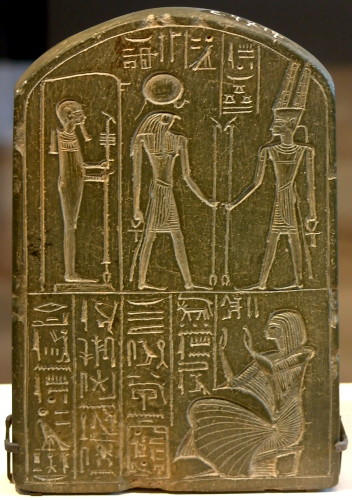
Egyptian Stele, typical round-top stone tablet, in Louvre Museum of Paris, Egyptian Antiquities Department, 1st Floor, Room 38, Artifact E-7717
While the Bible does not mention the shape of the Ten Commandments, it is clear that the text was engraved on two stone tablets: “And the Lord said… I will give thee tables [tablets] of stone, and a law” (Exodus 24:12); “And he gave… two tables of testimony, tables of stone” (Exodus 31:18); “And the writing was the writing of God, graven upon the tables.” (Exodus 32:16)
The classical depiction of the Ten Commandments as round-topped stone tablets comes from the distinctly Pharaonic Egyptian practice of “Stelae”, the Greek and Latin word for tablets, usually displayed as a monument, which are engraved with text and images. The use of Stelae, most often for official government notices to the general public, originates primarily from the First Dynasty of ancient Egypt, from ca. 3,100 BC.
Archaeology has established that the original form of Stelae was as pairs of two stone tablets, which almost always featured rounded tops: “The earliest… royal stelae at Abydos consisted of pairs of large stone-carved slabs… Votive stelae, usually placed in temples, were principally rectangular, round-topped slabs”. [76]
Therefore, the Ten Commandments, as a public declaration for religious devotion, written on a pair of stone tablets, is conclusively identified as a proper Egyptian Stela in the tradition of the Ancient Priesthood, which would necessarily be engraved on round-topped stones.
It is interesting to note that it is these very same round-topped engraved stone tablets, from the Ancient Priesthood of Egypt, which became the traditional European style of “tombstones” or “gravestones”, especially as used in Victorian cemeteries.
Sacraments and Communion – The Christian practices of Holy sacraments, and the Communion of the Eucharist, derive from the Magi Priesthood of Melchizedek, as demonstrated by the Sumerian Melchizedek blessing Abraham with “bread and wine” when they were in Assyria (Genesis 14:18-20) [77].

‘Sacred Lake’ of Holy Water for priestly purification, at Habu Temple in Thebes (dated ca. 1,515 BC)
Consecrations– The Catholic practice of consecrating Clergy, and consecrating their ceremonial vestments and implements, originated from in the Ancient Priesthood in Egypt, which was influenced by the earlier Sumerian tradition. The Egyptian hieroglyphic word ‘Se Neter’ 𓋴 𓊹, meaning to “consecrate”, literally means to “infuse with the Holiness of God”, which is the purpose and effect of ceremonial consecration. [78]
Baptism & Holy Water – The Christian rite of Baptism, and the Catholic use of Holy Water, were originally practices of the Ancient Priesthood in Egypt: Since the earliest era of Egyptian Temple building from ca. 3,000 BC, almost all of the Egyptian Temples featured a “Sacred Lake”, as most notably seen at Karnak Temple in Luxor, called ‘Shi-Netjer’ 𓈚 𓇌 𓈖 𓏏𓆓 𓂋 meaning “divine lake”, containing the water used in purification rituals. Archaeologists established that “the sacred lake represented in a tangible manner the same underlying forces of life and creation”, thus embodying the original ancient practice of Holy Water 𓊹 𓈗, and Baptism by Holy Water 𓀆. [79] Special Priests who administered sacraments such as Baptism using Holy Water were called “Wab Priests (‘purifiers’)” 𓅱 𓄿 𓃀 [80].
 Structure of Ranks of Clergy – The Catholic system of the ranks of Clergy also comes directly from the Ancient Priesthood in Egypt: Pharaonic Egyptian language shows a wide range of different titles for Priests, evidencing various types and levels of priestly service. Templar Grand Master Prince Matthew of Thebes recovered and restored the Egyptian titles of the Ancient Priesthood, working from the most authoritative source for hieroglyphic translations, the work of the British Egyptologist Sir Alan Gardiner (1879-1963). [81]
Structure of Ranks of Clergy – The Catholic system of the ranks of Clergy also comes directly from the Ancient Priesthood in Egypt: Pharaonic Egyptian language shows a wide range of different titles for Priests, evidencing various types and levels of priestly service. Templar Grand Master Prince Matthew of Thebes recovered and restored the Egyptian titles of the Ancient Priesthood, working from the most authoritative source for hieroglyphic translations, the work of the British Egyptologist Sir Alan Gardiner (1879-1963). [81]
Analysis and correlation of related hieroglyphic words reveals a comprehensive working system of hierarchy and ranks of Clergy. The resulting titles and functions of the Egyptian Priests are specifically equivalent to all types and levels of the classical Catholic Clergy, directly matching in every detail. Indeed, such perfect mirroring evidences that the Egyptian system is in fact the original pre-Christian source of the later classical Christian ecclesiastical structure of the Roman Catholic Clergy.
As a result, the Pontifical denomination of Ancient Catholicism, embodying the Ancient Priesthood of Solomon, properly uses the Roman Catholic system for ranks of Clergy. In modern practice of the Ancient Apostolic Church, the classical Christian titles are used as primary indications, often supplemented by the English translation from ancient Egyptian, or by the transliteration of Egyptian pronunciation, as secondary indications.
Those ranks and titles of Clergy are as follows: Acolyte (Initiate: Immy Sitaa: 𓏶 𓅓 𓊨 𓎳 𓀀) [82]; Deacon (Lector Priest: Khry Hebit: 𓎳 𓀀) [83]; Priest (Priest of Purity: Hem Wab: 𓀆) [84]; Monsignor (Priest of God: Hem Neter: 𓊹 𓍛 𓏤 𓀀) [85]; Doctor of Divinity (Scribe of the Word of God: Sesh Mediw Neter: 𓏞 𓀀 𓆵 𓊹) [86]; Bishop (High Priest: Sem Tery: 𓋴 𓅓 𓋼 𓆵 𓀢) [87]; Archbishop (Arch High Priest: Meti N Sa: 𓅓𓋼 𓇌 𓀀 𓈖 𓊏 𓎃) [88]; Cardinal (Master High Priest: Miter Sem Tery: 𓅓 𓋼 𓂍 𓋴 𓅓 𓀢) [89]; Pontiff (First Master-Teacher of God: Miter Neter Tepi: 𓅓 𓋼 𓂍 𓊹 𓁐 𓌐 𓁶 𓊪) [90].
The following are especially interesting to note: The phrase ‘Sem Tery’ (used for the Bishop and Cardinal titles) is the origin of the English word “cemetery”, because only a High Priest(ess) could perform the advanced sacraments for funerary Temples; The word ‘Miter’ (used for the Cardinal and Pontiff titles) is the origin of the English word “Mitre” (pronounced “myter”), the name for the Catholic pointed Bishop’s hat, because it signifies a Bishop representing Pontifical authority.
In the Ancient Apostolic Church, all ranks of Clergy also have alternate feminine grammatical forms, for equal use by women at all levels, as this is found in the hieroglyphic linguistics from the original Ancient Priesthood in Egypt.
The denomination of Ancient Catholicism authentically requires a total of seven active working ranks of Clergy (Deacon, Priest, Monsignor, Doctor of Divinity, Bishop, Archbishop, and Cardinal), mirroring the Egyptian structure. This is necessary to fulfill the ancient requirement of seven levels of initiation, in a sequential progression of priestly development and spiritual mastery:
Apostolic extracanonical manuscripts in the historical record, preserved by the Essenes, document a 1st century Christian practice of Episcopal consecration, by a prayer for cleansing “the seven houses, that thy rest may be in the seventh house… [to] give them the added seal” [91]. These seven levels of spiritual cleansing were part of a progression for spiritual ascent of the soul, through prayerful work with “seven spheres” of Holy Spirit energy [92]. This practice was based upon the Old Testament scripture: “Wisdom hath builded her house, she hath hewn [carved] out her seven pillars” (Proverbs 9:1) [93].
For these reasons, 12th century Ancient Catholicism properly uses all seven Roman Catholic levels of Clergy. (This differs from the later 19th century Old Catholic Movement, which omits the 3rd ordination of Monsignor, and has only administrative appointment of “Metropolitan Archbishops” instead of the consecration of Cardinal, thereby omitting the 7th initiation.)
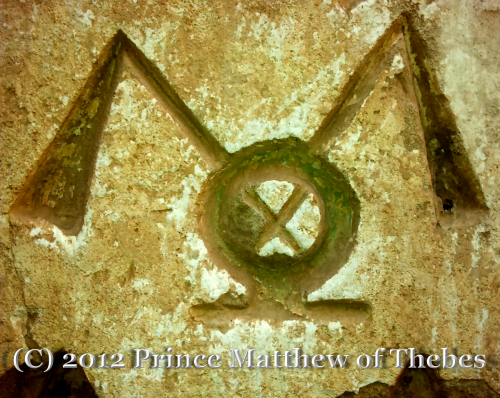
‘Keys of Habu Temple’ (ca. 1,515 BC), discovered by Prince Matthew of Thebes in North Chamber by Holy of Holies of Habu Temple, the origin of ‘Saint Peter’s Keys’
Saint Peter’s Keys – One major iconic symbol of Christianity, featured in the ecclesiastical heraldry of the Vatican Holy See of the Roman Catholic Church, is the “Keys of Saint Peter”. Templar archaeology proves that this also comes directly from the Ancient Priesthood in Egypt:
The classical Christian symbol consists of two crossed keys, with the working end of the keys on top hanging down as flags, with circles at the bottom of both keys, decorated by four notches suggesting an invisible “X” within each circle.
Templar Grand Master Prince Matthew of Thebes discovered a very rare symbolic hieroglyph, never before mentioned by any archaeologist, in the North Chamber next to the Holy of Holies in the Temple of Medinat Habu in Thebes (modern Luxor): It consists of two crossed flagpoles, with the working end of the flags hanging down, with the poles forming an “X” inside a circle, thereby closely resembling Saint Peter’s Keys.
The “Keys of Habu Temple” symbol is dated to ca. 1,515 BC, based upon the 18th Dynasty period of construction of the Temple in Thebes (near Valley of the Queens) and its association with Amenhotep I. [94]
The symbology of Saint Peter’s Keys comes from the Biblical account of Jesus, describing the function and power of Bishops to the Apostle Peter: “I will give unto thee the keys of the kingdom of heaven; and whatsoever thou shalt bind on earth shall be bound in heaven; and whatsoever thou shalt loose on earth shall be loosed in heaven.” (Matthew 16:19) [95]
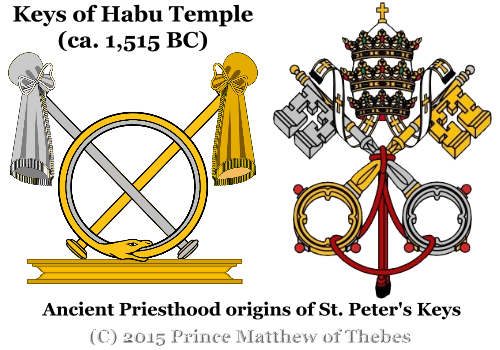 Linguistic analysis of the Keys of Habu Temple hieroglyph shows that it is a special hybrid of several known hieroglyphs, which thereby reveal its meaning: A flag is the hieroglyph ‘Zez’ 𓌅 (ZHZ) meaning to “move” something; Two crossed flags protruding up from a circle on a base line is ‘Demid’ 𓋬 (DMD) meaning to “bind”; A circle on a base line 𓍶 also means to “bind”; Two flags protruding up from being crossed is ‘Maat’ 𓐒(MAT) meaning “heavens”; An “X” within a circle is both ‘Niwet’ 𓊖 (NIWT) meaning “lower heaven”, and also ‘Per’ 𓊖 (PR) meaning “Temple”.
Linguistic analysis of the Keys of Habu Temple hieroglyph shows that it is a special hybrid of several known hieroglyphs, which thereby reveal its meaning: A flag is the hieroglyph ‘Zez’ 𓌅 (ZHZ) meaning to “move” something; Two crossed flags protruding up from a circle on a base line is ‘Demid’ 𓋬 (DMD) meaning to “bind”; A circle on a base line 𓍶 also means to “bind”; Two flags protruding up from being crossed is ‘Maat’ 𓐒(MAT) meaning “heavens”; An “X” within a circle is both ‘Niwet’ 𓊖 (NIWT) meaning “lower heaven”, and also ‘Per’ 𓊖 (PR) meaning “Temple”.
Therefore, the Keys of Habu hieroglyph embodies a whole sentence: “Zez Demid Mat Niwet Per” 𓌅 𓋬 𓐒 𓊖 𓊖 : “Move to bind the heavens by the lower heaven of the Temple” [96]. This is a direct paraphrase of precisely the same sentence which Jesus spoke to Peter: “What you move to bind or loose in the Temple shall be moved in heaven.”
Veneration of Angels & Saints – The Catholic practice of displaying statues and images of Angels and Saints also comes from the Ancient Priesthood in Egypt. The so-called “gods” and “goddesses” of the Temples and papyrus scrolls were a prejudicial mistranslation of the hieroglyph of a flag for the word ‘Neter’ 𓊹 (Ntr) only as “God”, despite its proven alternate meanings as “Holy”, “Angelic” or “Saintly”. The plural form ‘Neterwoo’ 𓊹 𓊹 𓊹 (Ntrw) was thus superficially mistranslated as “gods”, although it was authentically used only to mean Angels and Saints, literally as “Holies”, or “of Holiness”. The phonetic “-ter” (tr) word ending is from the word ‘Tery’ 𓋼 𓆵 𓀢 (t-r-y) meaning “Holiness”. The plural suffix “-woo” (wu) grammatically means “from” or “of”, as proven by the word ‘NiwtyWoo’ 𓊖 𓏏 𓅂 𓏨 (Nwtw) meaning people “of” the Temple. Thus Angels are “Holies from God”, and Saints are “People of God”, all within a distinctly monotheistic theology. [97]
It is for these reasons, that the Egyptian ‘Neterwoo’ later became the English word “Netherworld”, the heavenly realm of Angels and Saints [98]. Old Testament scriptures confirm use of the word “gods”, specifically referring to Saints and Angels: God speaks about judgment over living humans to determine Sainthood as “gods” (Isaiah 41:21-23), and God speaks to the Angels calling them “gods” (Psalm 82:1-7). [99] In the New Testament, Jesus confirms that the Old Testament references to “gods” also include mortal human Prophets and Apostles who receive “the word of God” to become Saints (John 10:34-35) [100].
These facts conclusively prove that there was no supposed “polytheism” in ancient Egypt, and they never “worshipped gods”. Rather, they simply practiced the Veneration of Angels and Saints with paintings, carvings and statues, precisely as is widely and canonically practiced in classical Christianity since the 1st century.
The Vatican’s Second Council of Nicea in 787 AD primarily restored “the veneration of holy images” as the display and veneration of icons and statues [101]. This was supported by the Holy See of Antioch, and actually declared that “All writings against the venerable images are… heretical” [102]. Such veneration of Angels and Saints is canonical based upon the Ark of the Covenant (Exodus 25:19; Numbers 7:89) and the Temple of Solomon (Ezekiel 41:18-20), as confirmed by the Apostles (Hebrews 9:5) [103].
Suggested Topics Related to this Information
Click to learn about the Ancient Apostolic Church as a Pontifical institution.
Click for details about Membership & Participation in the Ancient Apostolic Church.
Click for details of the Apostolic Succession Lines within Ancient Catholicism.
Academic Source References
[1] Michael Lamy, Les Templiers: Ces Grand Seigneurs aux Blancs Manteaux, Auberon (1994), Bordeaux (1997), p.28.
[2] Keith Laidler, The Head of God: The Lost Treasure of the Templars, 1st Edition, Weidenfeld & Nicolson, London (1998), p.177.
[3] Piers Paul Read, The Templars: The Dramatic History of the Knights Templar, the Most Powerful Military Order of the Crusades, 1st Edition, Weidenfeld & Nicolson, London (1999), Phoenix Press, London (2001), Orion Publishing Group, London (2012), p.305.
[4] Malcolm Barber & Keith Bate, The Templars: Selected Sources, Manchester University Press (2002), p.2.
[5] Titus Flavius Josephus, Jewish War, Rome (78 AD); Translation by William Whiston (1736), Loeb Classical Library (1926), Volume II, Book 5, pp.212, 217.
[6] Charles G. Addison, The History of the Knights Templar (1842), p.6, citing the document De Aedificiis by the 5th century Byzantine historian Procopius of Caesarea as “Procopius de Oedificiis Justiniani, Lib. 5.”
[7] Charles G. Addison, The History of the Knights Templar (1842), pp.4-5, citing a Vatican document by the 13th century Pope Urban IV (Jacques Pantaleon, 1195-1264), the Latin Patriarch of Jerusalem, as “Pantaleon, Lib. iii. p. 82.”
[8] Collier’s Encyclopedia, Thomson Gale (1985), 1985 Edition, Macmillan Library Reference (1990), “Knights Templars”.
[9] Old Testament, Authorized King James Version (AKJV), Cambridge University Press (1990), Ezekiel describing Egyptian Priesthood inscriptions and figures inside the Temple of Solomon, Ezekiel 8:10-11.
[10] Titus Flavius Josephus, Jewish War, Rome (78 AD); Translation by William Whiston (1736), Loeb Classical Library (1926), Volume II; See pp.212, 217; The Temple contained “Babylonian” decorations of “mystical interpretation… a kind of image of the universe… all that was mystical in the heavens… [and] signs, representing living creatures.” (Book 5, Chapter 5, Part 4) Other symbols “signified the circle of the Zodiack” (Book 5, Chapter 5, Part 5).
[11] Titus Flavius Josephus, The Life of Flavius Josephus, Rome (ca. 96 AD); Translation by William Whiston (1736), Loeb Classical Library (1926), Volume I; See p.65; The Temple replica rebuilt by King Herod also “had the figures of living creatures in it” (Part 12).
[12] Prof. Arthur Samuel Peake (Editor), A Commentary on the Bible, T.C. & E.C. Jack, Ltd., London (1920), Ezekiel 8:10-11; Dr. Peake was Professor of Biblical Exegesis at University of Manchester, a Master of Arts and Doctor of Divinity.
[13] Karl Heinrich Rengstorf, Hirbet Qumran and the Problem of the Library of the Dead Sea Caves, German edition (1960), Translated by J.R. Wilkie, Leiden Press, Brill (1963).
[14] Jean-Baptiste Humbert, L’espace sacre a Qumran: Propositions pour l’Archeologie, Revue Biblique, Issue No.101 (1994), p.161-214.
[15] Minna and Kenneth Lonnqvist, Archaeology of the Hidden Qumran: The New Paradigm, Helsinki University Press, Helsinki (2002).
[16] Eric Meyers, The Oxford Encyclopedia of Archaeology in the Near East, Oxford University Press, Oxford (1997), Vol.2, pp.268-269.
[17] New Testament, Authorized King James Version (AKJV), Cambridge University Press (1990), Matthew 2:13-15.
[18] Charles F. Potter, The Lost Years of Jesus Revealed, Random House Publishers (1958): “The… [Qumran] scrolls of the great Essene library… near the Dead Sea have given us an answer at last. That during those ‘lost years’ [ages 12-30] Jesus was a student at this Essene school is becoming increasingly apparent.”
[19] Menahem Mansoor, The Dead Sea Scrolls: A College Textbook and a Study Guide, Brill Publishers (1964), p.156: “the unknown years in the life of Jesus (ages 12-30) might have been spent with the sect” of the Essenes in Alexandria.
[20] H. Spencer Lewis, The Mystical Life of Jesus, Ancient and Mystical Order Rosae Crucis, San Jose (1982).
[21] New Testament, Authorized King James Version (AKJV), Cambridge University Press (1990), Acts 24:5: “For we have found this man [Saint Paul] a pestilent fellow, and a mover of sedition among all the Jews throughout the world, and a ringleader of the sect of the Nazarenes.” (This conclusively proves that the Nazarenes, and thus also the Essenes, were never “Jewish”, as is widely and frequently claimed, but rather exclusively pre-Christian and early Christian, and wholly rejected by Judaism.)
[22] Frank Ely Gaebelein (Editor), The Expositor’s Bible Commentary: with the New International Version, 12 Volume Set, Zondervan Press (1988): The Gospel of “Matthew certainly used Nozaraios as an adjectival form of apo Nazaret (‘from Nazareth’ or ‘Nazarene’) even though the more acceptable adjective is Nazarenos” (Nazarene), which is correctly used elsewhere in the New Testament.
[23] Professor Ted Nottingham, The Mystery of the Essenes, Video of Lecture at Northwood Christian Church, Indianapolis Indiana (2010), at 24:04 and 26:00 min.
[24] Ethel Stephana Drower, The Secret Adam: A Study of Nasoraen Gnosis, Oxford University Press, London (1960), pp.ix, xiv, xvi: The original word “Nasuraiia” (Nazarenes) means the pre-Christian Gnostic Mandaen Nasoraens, who were persecuted by the Jews and thus forced to flee Jerusalem before its fall.
[25] Geoffrey W. Bromiley, The International Standard Bible Encyclopedia, Fully Revised Edition, Eerdmans Publishing Company (1982), Volume 3, “Nazarene”, pp.499-500.
[26] New Testament, Authorized King James Version (AKJV), Cambridge University Press (1990), Matthew 2:23: “what had been spoken through the prophets might be fulfilled, ‘He will be called a Nazorean.’”
[27] Alan Butler & Stephen Dafoe, The Warriors and Bankers, Lewis Masonic, Surrey, England (2006), p.20.
[28] Henri de Curzon, La Règle du Temple, La Société de L’Histoire de France, Paris (1886), in Librairie Renouard: “Holy Communion”, “this Religion” (Rule 2); “the Religion of knighthood” (Rule 14); “type of new Religion”, “Religion of Knights”, “Religion by armed knighthood” (Rule 57), “in every Religion” as including the Templar Order (Rule 71).
[29] Henri de Curzon, La Règle du Temple, La Société de L’Histoire de France, Paris (1886), in Librairie Renouard: “Disciples” of the Grand Master as a Pontiff (Rule 7); “Patriarchate of the Temple of Solomon” in subtle Old Latin phrase (Rule 8); “divine service… dressed with the crown” as ecclesiastical sovereignty (Rule 9); Grand Mastery exercising independent ecclesiastical authority (Rule 62); “servants of the Church” under Grand Master as a Pontiff (Rule 64).
[30] Henri de Curzon, La Règle du Temple, La Société de L’Histoire de France, Paris (1886), in Librairie Renouard: “manner and establishment… we heard” (Rule 3); “presented… the customs and observances… to make all known” (Rule 7); priestly origins “considered and examined through diligence” (Rule 8).
[31] Malcolm Barber & Keith Bate, The Templars: Selected Sources, Manchester University Press (2002), p.8.
[32] Michael Lamy, Les Templiers: Ces Grand Seigneurs aux Blancs Manteaux, Auberon (1994), Bordeaux (1997), p.28.
[33] Pope Innocent II, Omne Datum Optimum (29 March 1139), translated in: Malcolm Barber & Keith Bate, The Templars: Selected Sources, Manchester University Press (2002), pp.59-64.
[34] Hector Avalos, How Archaeology Killed Biblical History, Lecture Video, Minnesota Atheists Conference, USA (October 21, 2007), Part 1, “By 1900 AD… Solomon had a kingdom that stretched from Egypt to Iraq” (at 12:30 min); Hector Avalos holds a Masters in Theological Studies from Harvard Divinity School, and Ph.D. in Biblical Studies from Harvard University.
[35] Old Testament, Authorized King James Version (AKJV), Cambridge University Press (1990), I Kings 4:21.
[36] Charles Van der Pool, The Apostolic Bible Polyglot: Greek-English Interlinear, 2nd Edition, The Apostolic Press, Newport, Oregon (2013), I Kings 4:21.
[37] NAS Exhaustive Concordance of the Bible, The Lockman Foundation (1981), Greek Dictionary: “Heos”, “Horion”.
[38] Old Testament, Authorized King James Version (AKJV), Cambridge University Press (1990), I Kings 4:21.
[39] Old Testament, Authorized King James Version (AKJV), Cambridge University Press (1990), I Kings 4:30.
[40] Charles Van der Pool, The Apostolic Bible Polyglot: Greek-English Interlinear, 2nd Edition, The Apostolic Press, Newport, Oregon (2013), I Kings 4:30.
[41] NAS Exhaustive Concordance of the Bible, The Lockman Foundation (1981), Greek Dictionary: “Plethos”.
[42] J. Huehnergard, A Grammar of Akkadian, Eisenbrauns, Winona Lake (2005).
[43] Andrew George, Babylonian and Assyrian: A History of Akkadian, in J.N. Postgate (Editor), Languages of Iraq, Ancient and Modern, British School of Archaeology in Iraq, London (2007), pp.31-71.
[44] William L. Moran, The Amarna Letters, 1st Edition, Johns Hopkins University Press (1992), p.43.
[45] Old Testament, Authorized King James Version (AKJV), Cambridge University Press (1990), I Kings 1:39: “Zadok the Priest took an horn of oil out of the tabernacle, and anointed Solomon. And… all the people said, God save King Solomon.”
[46] James Strong, The Exhaustive Concordance of the Bible, “Strong’s Concordance”, Jennings & Graham, Cincinnati (1890), “Melek”, No.4428; “Sedeq”, No.6666.
[47] Van der Toorn, Becking & Van der Horst, Dictionary of Deities and Demons in the Bible, 1st Edition (1995), 2nd Revised Edition, Eerdmans Publishing (1999), “Elyon”, “Shalem”.
[48] Willard M. Swartley, Covenant of Peace, Eerdman’s Publishing (2006), p.255; Gary Staats, A Christological Commentary on Hebrews (2012), p.71.
[49] Old Testament, Authorized King James Version (AKJV), Cambridge University Press (1990), “And the king said unto Zadok, Carry back the Ark of God into the city” (II Samuel 15:25); “The king said also unto Zadok the priest, Art not thou a seer?” (II Samuel 15:27); God says: “But the priests… the sons of Zadok, that kept the charge of my sanctuary when the children of Israel went astray from me” (Ezekiel 44:15); “It shall be for the priests that are sanctified of the sons of Zadok; which have kept my charge, which went not astray when the children of Israel went astray, as the Levites went astray.” (Ezekiel 48:11).
[50] James Strong, The Exhaustive Concordance of the Bible, “Strong’s Concordance”, Jennings & Graham, Cincinnati (1890), “Melek”, No.4428; “Sedeq”, No.6666.
[51] Old Testament, Authorized King James Version (AKJV), Cambridge University Press (1990), Genesis 14:18: “Melchizedek king of Salem… was the priest of the most high God.”
[52] New Testament, Authorized King James Version (AKJV), Cambridge University Press (1990), Hebrews 7:1-2: “Melchisedec, king of Salem, priest of the most high God… first being by interpretation King of Righeousness, and after that also King of Salem, which is, King of Peace”.
[53] Van der Toorn, Becking & Van der Horst, Dictionary of Deities and Demons in the Bible, 1st Edition (1995), 2nd Revised Edition, Eerdmans Publishing (1999), “Elyon”, “Shalem”.
[54] New Testament, Authorized King James Version (AKJV), Cambridge University Press (1990), Hebrews 7:1-3: “Melchisedec… priest of the most high God… without father, without mother, without descent [genealogy], having neither beginning of days, nor end of life; but… abideth a priest continually.”
[55] Ian Shaw & Paul Nicholson, British Museum Dictionary of Ancient Egypt, British Museum Press, London (1995), The American University in Cairo Press, Cairo (1996), “Nubia”, pp.204-205.
[56] Juris Zarins, Early Pastoral Nomadism and the Settlement of Lower Mesopotamia, Bulletin of the American Schools of Oriental Research, Issue 280, pp.31-65.
[57] Ian Shaw & Paul Nicholson, British Museum Dictionary of Ancient Egypt, British Museum Press, London (1995), The American University in Cairo Press, Cairo (1996), “Nubia”, p.206.
[58] New Testament, Authorized King James Version (AKJV), Cambridge University Press (1990), Genesis 14:18-20; Hebrews 7:1.
[59] New Testament, Authorized King James Version (AKJV), Cambridge University Press (1990), Hebrews 7:9: “Levi also, who receiveth tithes, payed tithes in [to] Abraham. For… Melchisedec met him.”
[60] New Testament, Authorized King James Version (AKJV), Cambridge University Press (1990), I Kings 1:39: “Zadok the Priest took an horn of oil out of the tabernacle, and anointed Solomon. And… all the people said, God save King Solomon.”
[61] New Testament, Authorized King James Version (AKJV), Cambridge University Press (1990), Hebrews 5:5; 5:6; 5:10.
[62] Charles Van der Pool, The Apostolic Bible Polyglot: Greek-English Interlinear, 2nd Edition, The Apostolic Press, Newport, Oregon (2013), Hebrews 5:5; 5:6; 5:10.
[63] James Strong, The Exhaustive Concordance of the Bible, “Strong’s Concordance”, Jennings & Graham, Cincinnati (1890), “Archiereus”, No.749.
[64] New Testament, Authorized King James Version (AKJV), Cambridge University Press (1990), Hebrews 5:6, 5:10, 6:20, 7:17, 7:20.
[65] Charles Van der Pool, The Apostolic Bible Polyglot: Greek-English Interlinear, 2nd Edition, The Apostolic Press, Newport, Oregon (2013), Hebrews 5:6, 5:10, 6:20, 7:17, 7:20.
[66] James Strong, The Exhaustive Concordance of the Bible, “Strong’s Concordance”, Jennings & Graham, Cincinnati (1890), “Kata”, No.2596; “Taxis”, No.5010.
[67] New Testament, Authorized King James Version (AKJV), Cambridge University Press (1990), Hebrews 5:1, 10:21.
[68] Sir Alan G. Gardiner, Egyptian Grammar: The Study of Hieroglyphs, Ashmolean Museum of Oxford University, Griffith Institute, Oxford (1927), “Aten” (Spirit of Sun Rays = Christian “Holy Spirit” or “Power of God”), List of Hieroglyphic Signs (pp.438 et seq.): “Aten”, N8; “Ka” (“Spirit”, Hands used on the Aten rays), D28.
[69] Donald B. Redford, The Oxford Encyclopedia of Ancient Egypt, The American University in Cairo Press (2001), Vol.1, “Aten”, p.157.
[70] Sir Alan G. Gardiner, Egyptian Grammar: The Study of Hieroglyphs, Ashmolean Museum of Oxford University, Griffith Institute, Oxford (1927), “Aten”, N8.
[71] Donald B. Redford, The Oxford Encyclopedia of Ancient Egypt, The American University in Cairo Press (2001), Vol.1, “Aten”, p.156.
[72] Donald B. Redford, The Oxford Encyclopedia of Ancient Egypt, The American University in Cairo Press (2001), Vol.1, “Aten”, pp.157-158.
[73] New World Encyclopedia, Paragon House Publishers (September 2013), “Egyptian Book of the Dead”, “Spell 125: The Negative Confessions”.
[74] Miriam Lichtheim, Ancient Egyptian Literature: A Book of Readings, Volume 2, University of California Press (1976), Part 3: “From the Book of the Dead”, “Chapter 125” at p.124.
[75] Sir Earnest Alfred Wallis Budge, The Book of the Dead (1895), Grammercy Books, Random House Publishing, New York (1999), official translation by 19th century archaeologists, Chapter CXXV (125): “The Negative Confession”, from the Papyrus of Ani, at p.576.
[76] Ian Shaw & Paul Nicholson, British Museum Dictionary of Ancient Egypt, The Trustees of the British Museum, London (1995), The American University in Cairo Press (1996), “Stele”, p.278.
[77] New Testament, Authorized King James Version (AKJV), Cambridge University Press (1990), Genesis 14:18-20.
[78] Sir Alan G. Gardiner, Egyptian Grammar: The Study of Hieroglyphs, Ashmolean Museum of Oxford University, Griffith Institute, Oxford (1927), “Se Neter” (“Infuse with God” = Christian “Consecrate”), List of Hieroglyphic Signs (pp.438 et seq.): “S NTR” (“Consecrate”), S29-R8, R8-T22-X1-D21; “NTR” (“God”, Holiness, Astral), R8, R8-N14.
[79] Richard H. Wilkinson, The Complete Temples of Ancient Egypt, Thames & Hudson, London (2000), pp.12-13, p.72.
[80] Ian Shaw & Paul Nicholson, British Museum Dictionary of Ancient Egypt, The Trustees of the British Museum, London (1995), The American University in Cairo Press, Cairo (1996), “Priests”, p.228.
[81] Sir Alan G. Gardiner, Egyptian Grammar: The Study of Hieroglyphs, Ashmolean Museum of Oxford University, Griffith Institute, Oxford (1927), “List of Hieroglyphic Signs” (pp.438 et seq.), “Egyptian-English Vocabulary” (pp.549 et seq.), “English-Egyptian Vocabulary” (pp.605 et seq.).
[82] Sir Alan G. Gardiner, Egyptian Grammar: The Study of Hieroglyphs, Ashmolean Museum of Oxford University, Griffith Institute, Oxford (1927), “Immy Sitaa” (“Initiate” = Christian “Acolyte”), List of Hieroglyphic Signs (pp.438 et seq.): “IMY” (“who is in”), M17-Z11-G17-Z4, Z11, Z11-G17; “ST A” (library, “place of records archive”), Q1-X1- D36-Y1, Q1-X1-O1-D36,Y2.
[83] Sir Alan G. Gardiner, Egyptian Grammar: The Study of Hieroglyphs, Ashmolean Museum of Oxford University, Griffith Institute, Oxford (1927), “Khry Hebit” (“Lector Priest” = Christian “Deacon”), List of Hieroglyphic Signs (pp.438 et seq.): “XRY HBT” (“Lector Priest”), V28-T28-D58, W5A-A1, W5, T28-D21-V28-D58-W3-N5-A1; “XRY A” (“Apprentice, assistant”), T28-D21-D36-Z1-A1; “XRY” (base level, “ground floor”, “lower”), T28-D21-Z4; “HBT” (“ritual book”), V28-D58-X1-W3-V12, W4-X1-Y1.
[84] Sir Alan G. Gardiner, Egyptian Grammar: The Study of Hieroglyphs, Ashmolean Museum of Oxford University, Griffith Institute, Oxford (1927), “Hem Wab” (“Priest of Purity” = Christian Ordained “Priest”), List of Hieroglyphic Signs (pp.438 et seq.): “HM KA” (“soul priest”), D375-A1, D31, D375-M17-M17-D40-A1; “WAB” (“Wab Priest”), D60-N35A-A1, D60-A1;
[85] Sir Alan G. Gardiner, Egyptian Grammar: The Study of Hieroglyphs, Ashmolean Museum of Oxford University, Griffith Institute, Oxford (1927), “Hem Neter” (“Priest of God” = Christian “Monsignor”), List of Hieroglyphic Signs (pp.438 et seq.): “HM NTR” (“prophet”), R8-U36; “HM KA” (“soul priest”), D375-A1, D31, D375-M17-M17-D40-A1; “HM” (“majesty”), U36-A40, U36-Z1-G7; “NTR” (“God”), R8-N14.
[86] Sir Alan G. Gardiner, Egyptian Grammar: The Study of Hieroglyphs, Ashmolean Museum of Oxford University, Griffith Institute, Oxford (1927), “Sesh Mediw Neter” (“Scribe of the Word of God” = Christian “Doctor of Divinity”), List of Hieroglyphic Signs (pp.438 et seq.): “SSh” (“Scribe”), Y3-A1, O34-N37-Y1; “MDW NTR” (“Word of God”), R8-S43-D46-G43-A2, R8-S43-Y2, S43-D46-G43-Y1-Z2-R8.
[87] Sir Alan G. Gardiner, Egyptian Grammar: The Study of Hieroglyphs, Ashmolean Museum of Oxford University, Griffith Institute, Oxford (1927), “Sem Tery” (“High Priest” = Christian Consecrated “Bishop”), List of Hieroglyphic Signs (pp.438 et seq.): “SM” (“priest”), S29-G17-A1; “TRY” (“high priest”), D1-Q3-Z4, T8, D1-Q3.
[88] Sir Alan G. Gardiner, Egyptian Grammar: The Study of Hieroglyphs, Ashmolean Museum of Oxford University, Griffith Institute, Oxford (1927), “Meti N Sa” (“Arch High Priest” = Christian “Archbishop”), List of Hieroglyphic Signs (pp.438 et seq.): “MTY N SA” (“controller of priestly phyle”), D52-X1-N35-V16, D51-X1-Z4-A1-N35-V17-A1-Z2.
[89] Sir Alan G. Gardiner, Egyptian Grammar: The Study of Hieroglyphs, Ashmolean Museum of Oxford University, Griffith Institute, Oxford (1927), “Miter Sem Tery” (“Master High Priest” = Christian “Cardinal”), List of Hieroglyphic Signs (pp.438 et seq.): “MTR” (master or teacher, “instruct” and “exhibit virtues” as teaching), D52-X1-D21; “SM” (“priest”), S29-G17-A1; “TRY” (“high priest”), D1-Q3-Z4, T8, D1-Q3.
[90] Sir Alan G. Gardiner, Egyptian Grammar: The Study of Hieroglyphs, Ashmolean Museum of Oxford University, Griffith Institute, Oxford (1927), “Miter Neter Tepi” (“First Teacher of God” = Christian “Pontiff”), List of Hieroglyphic Signs (pp.438 et seq.): “MTR” (teacher, “instruct” and “exhibit virtues” as teaching), D52-X1-D21; “NTR” (“God”, Holiness, Astral), R8, R8-N14; “TPY” (“First High Priest”), D1-Q3-Z4, D1-Q3, T8; “TP” (Pontiff, “Chief” High Priest), D1-Z1, D1-Q3.
[91] Montague Rhodes James, The Apocryphal New Testament, Oxford University Press (1707), Clarendon Press, Oxford (1924), Acts of Thomas, 27.
[92] Montague Rhodes James, The Apocryphal New Testament, Oxford University Press (1707), Clarendon Press, Oxford (1924), Pistis Sophia, 36, pp.46-47.
[93] Old Testament, Authorized King James Version (AKJV), Cambridge University Press (1990), Proverbs 9:1.
[94] Richard H. Wilkinson, The Complete Temples of Ancient Egypt, Thames & Hudson, London (2000), Chapter 5, “Western Thebes: Medinet Habu”, p.193; “Chronology of the Temple Builders”, p.12.
[95] New Testament, Authorized King James Version (AKJV), Cambridge University Press (1990), Matthew 16:19.
[96] Sir Alan G. Gardiner, Egyptian Grammar: The Study of Hieroglyphs, Ashmolean Museum of Oxford University, Griffith Institute, Oxford (1927), “Zez Demid Mat Niwet Per” (“Move to Bind the Heavens by the Lower Heaven of the Temple”), List of Hieroglyphic Signs (pp.438 et seq.): “ZHZ” (Move, “shake” as a “flagellum”), S45; “DMD” (Bind, “Unite” as “knotted strips of cloth” bound together), S23; “SNW” (Bind, “cartouche” by “rope encircling a region” being “bound” to close the circle), V9; “MAT” (heavens, realm of God, as “kind of land”), Aa-6; “NIWT” (“lower heaven”), N35-X1-O49-N50, O49-X1-Z1, O49; “NIWTY” (divine house), O49-G4; “PR” (“Temple”), O49.
[97] Sir Alan G. Gardiner, Egyptian Grammar: The Study of Hieroglyphs, Ashmolean Museum of Oxford University, Griffith Institute, Oxford (1927), “Neterwoo” (“Gods” = Christian “Angels” and “Saints”), List of Hieroglyphic Signs (pp.438 et seq.): “NTRW” (Holies, such as Angels or Saints, mistranslated as “Gods”), R8-R8-R8, (Prophets speaking Holiness) R8-N35-M6-M6-M6; “HM NTR” (“Prophet” as a Saint), R8-U36; “NTR” (Holiness as Saintly: flag), R8, (Astral as Angelic: flag-star), R8-N14; “TRY” (Holiness or Divinity, as “high priest”), D1-Q3-Z4, T8, D1-Q3; “NIWTYW” (People, “citizens”, as “of” or “from” the Temple complex) O49-X1-G4-A1-Z2; “DWT NTR” (“Netherworld”: circled star), N15.
[98] Sir Alan G. Gardiner, Egyptian Grammar: The Study of Hieroglyphs, Ashmolean Museum of Oxford University, Griffith Institute, Oxford (1927), “Dewit Neter” (“Netherworld” as heavenly realm), List of Hieroglyphic Signs (pp.438 et seq.): “DWT NTR” (“Netherworld”: circled star), N15.
[99] Old Testament, Authorized King James Version (AKJV), Cambridge University Press (1990), Isaiah 41:21-23, “Produce your cause, saith the Lord; bring forth your strong reasons… Shew the things that are to come hereafter, that we may know that ye are gods; yea, do good.”; Psalm 82:1-7, “God standeth in the congregation of the mighty; He judgeth among the gods. … I have said, Ye are gods, and all of you are children of the Most High.”
[100] Old Testament, Authorized King James Version (AKJV), Cambridge University Press (1990), John 10:34-35, “Jesus answered them, Is it not written in your law, ‘I said, Ye are gods’? If he called them gods, unto whom the word of God came, and the scripture cannot be broken.”
[101] The Vatican, The Catholic Encyclopedia (1908), Volume 4, “Councils”, “III. Historical Sketch of Ecumenical Councils”, Part 7, p.425.
[102] The Vatican, The Catholic Encyclopedia (1911), Volume 11, “Nicaea, Councils of”, “II. Second Council of Nicaea”, p.46.
[103] The Holy Bible, Authorized King James Version (AKJV), Cambridge University Press (1990): For the Ark of the Covenant… “make one cherub [angel] on the one end, and the other cherub on the other end.” (Exodus 25:19; Numbers 7:89); For the Temple of Solomon: “And it was made with cherubims [angels]… From the ground unto above the door were cherubims… and on the wall of the Temple.” (Ezekiel 41:18-20); Confirmed in the New Testament: “And over it the cherubims [angels] of glory shadowing the mercyseat” (Hebrews 9:5).

